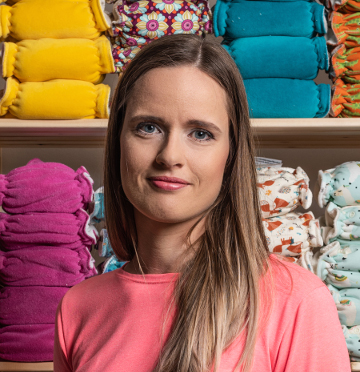You would like to try cloth period pads, but there’s still something holding you back? Might that Read more
In this article, we provide comprehensive information on diaper laundering as we recommend it in Anavy, so that you no longer have to fiddle with a lot of contradictory information circulating on the internet.
What to do with a diaper after taking it off a baby?
If you have used a disposable diaper liner, discard it into a dustbin if soilde or wash with the rest of the diapers if only wet. If you do not have a disposable liner, shake off the poop from the diaper into the toilet. What is left on the diaper is the easiest to remove with a shower/sprayer.
You can then apply bile soap on the stains. This step is not necessary, it depends on the performance of your detergent.
After the poop has been removed, put the diaper into the diaper pail until it is washed. Do not add any solution or pour water into the bucket, it would damage the diapers in a long run. You can refresh the bucket with a few drops of essencial oil on the lid. You should not store the diapers for more than 2-3 days, as mold or material damage may occur after this time.
Washing
We recommend to start with a separate rinse cycle with a spin to wash out the urine so that the main cycle will use clean water. Do not add any detergent to the rinse cycle. Prewash cycle is less suitable because it does not spin and so the soiled water remains in the main cycle.
When the rinse cycle is complete, run the main washing program at 60 degrees Celsius. We recommend only washing at 60 °C, not at 40 °C. Washing at 40 °C is not sufficient for destroying bacteria and pathogens, leading to stink issues and eventually damaging the diapers. You can add any light-colored laundry to the washing machine. The washing cycle should take about 2 hours, too long a washing cycle will cause unnecessary wear and tear and does not provide better washing results.
The choice of detergent depends entirely on you. You can use any commercially available washing powder or gel (it does not have to be a “sensitive” type). However, we do not recommend using homemade soap and soda mixture because there is a great risk of build-up in your laundry and washing machine.
When washing diapers, it is very important not to overfill the washing machine. The diapers are highly absorbent and if the washing machine is too full, the diapers are washed in an insufficient amount of water. Even rinsing will not remove the residues of poop and detergent perfectly, the diapers will develop build-up, harden and become stinky. So if you have a washing machine for 5 kg of dry laundry, for example, we recommend putting only 4-4.5 kg of diapers in it (one fitted diaper weighs approx. 250 g, so that means approx. 16-18 diapers for one wash). Also, it is useful to choose the "More Water" option if your washing machine allows it. The important thing is that rinsing is really good. You can also use an extra rinse. Do not use "ECO" washing programs to save water when washing diapers. It is compensated by a longer wash time, which might work for regular laundry, but not for diapers. It only causes excessive wear and tear, build-up and stink issues. Spin at the highest speed your washing machine allows.
Do not use fabric softener or any bleach (oxygen or chlorine)! Do not remove stains manually by scrubbing.
You can find information about the washing and maintenance of wool diaper covers in our article Care for wool diaper covers.
To find out about removing limescale and detergent build-up deposits, see our article How to remove detergent build-up or you can watch our instructional video right away.
Drying
Dry the diapers freely on a line or in a tumble dryer for a gentle program. To speed up the drying process, you can place the clothes dryer near a heater. Do not dry the diapers directly on a heater.
Sun-drying is also convenient, as the sun bleaches the stains very well. But make sure the print side of the diaper does not face the sun because the colors may fade.
Remember that diapers vary in drying time quite a lot. If you don't have the option of drying your diapers in a warm and dry room or in a tumble dryer in damp spring, autumn and winter days, prefer those types of diapers that are thin and dry quickly.
| ♥ What to DO |
Θ What NOT to do |
|
|
|
|
|
|
|
|
|
|
|
|
|
|
|
|
Troubleshooting
Thediapers are hard, coarse.
The best solution to this is a tumble dryer. If you can afford it financially or spatially, or you are not against it from environmental reasons, we can only recommend tumble drying. It has a downside to it, though. The diaper is facing a double load of wear and tear - and therefore I recommend carefully choosing the type of dryer (some of the dryers wear the clothes excessively). Line dried diapers are always slightly coarser than from a tumble dryer. The following steps will help to soften them:
- Washing according to the instructions, i.e. enough water, not overfilling the washing machine (see above)
- Proper detergent dosage - neither too much nor too little. The hardness of your water is important, always follow the manufacturers dosage based on water hardness in your area.
- If you use powder detergent, try switching to liquid. Powder detergents usually leave more deposits than gels.
- Use of the acid rinse aid - the acid rinse removes the residue of powder and limescale from the laundry and at the same time does not reduce their absorbancy as if it were a fabric softener.
The diapers are stinky, like a wet rag, even fresh from the wash. The diapers stinks shortly after being peed in.
- The cause may be that you overfill the washing machine so there is insufficient amount of water in the cycle, rinsing or insufficient detergent dosage, see above
- To remove the bacteria causing odor, you can use a laundry disinfectant, for example Dettol or Sanytol. You may learn on the packaging that it should be dispensed into the fabric softener compartment, but we DO NOT RECOMMEND that. Instead, we recommend adding it to the main wash cycle, in the amount indicated on the package (= one lid). This ensures that it is subsequently rinsed from the laundry and does not come into contact with the baby's skin.
TIP! Use the same "treatment" after having undergone a gut infection on all diapers.
Spots remain on the diapers.
In particular, we recommend that you consider whether the diaper stains are really a problem for you. Some are difficult to remove (they will fade over time) and diapers are not wedding dresses. However, we have some tips for you.
- Sunshine - bleaches stains from yellow yellow stool very efficiently. But try to hang the diapers so that the sun does not shine directly on the colored side of the diaper to prevent the print from fading.
- Bile Soap - apply on stains before putting the diaper in a bucket
- What NOT TO DO - bleaches (oxygen = sodium percarbonate or chlorine): never pour bleach directly onto the fabric as it may be damaged. Also never scrub the stains.
Vinegar or acid rinse and bamboo diapers?
Some mothers use vinegar or acid rinse for softening and refreshing diapers successfully. But some are concerned that vinegar can destroy the bamboo fiber. According to our experience, you do not have to be afraid of using vinegar or acid rinse in a reasonable amount (do not put in the main wash, use the softener tray).
If you have further questions that this article did not answer, please do not hesitate to contact us, we will be happy to advise you.

